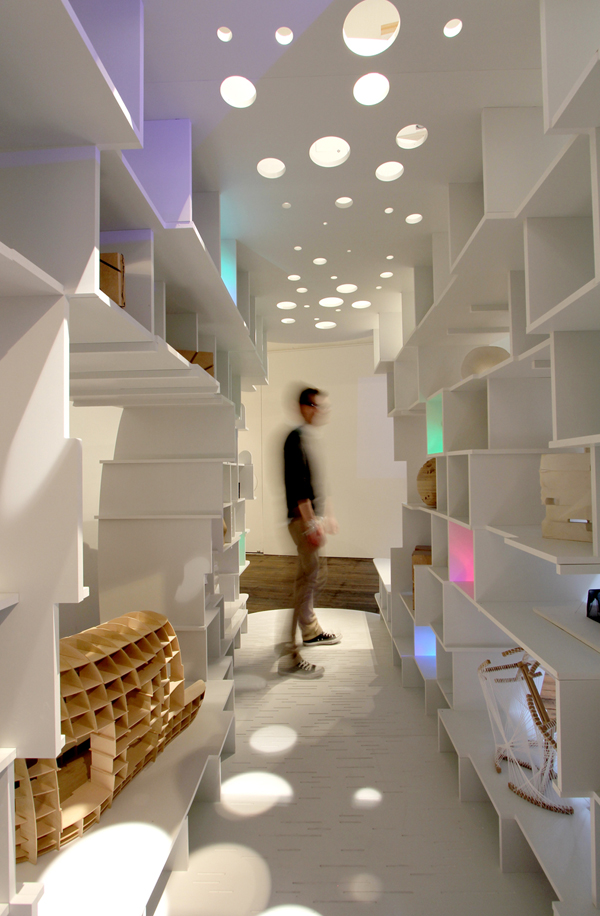




Image Credit : Photography by Richard Maddock and Joel Collins

Project Overview
The Machining Aesthetics exhibition positions craft at the forefront of architectural practice. The exhibition examines architectural design as material and craft production. Through making procedures, the spatial and material prototypes presented in this exhibition explore the interface between material, effects and digital technology. The exhibition features models and drawings of 9 +1 projects; each project delivering a vision for a new home for Craft (formerly Craft Victoria).
Conducted as a design research studio at the Melbourne School of Design at the University of Melbourne, the studio explores new aesthetics in digital fabrication. The exhibition took place at Gallery 2, Craft from 1st August to 31st August 2013.
Organisation
Team
Vessel design: LLDS with Marc Micuta and Richard Maddock
Graphic Design: Joel Collins
Curator: Joel Pascoe
ARTISTS:
Jean Bachoura, Tim Cameron, Zheren Chen, Joel Collins, Kristina Fefelova, Bo Hu, Ruobing Li, Ching Yu Liao, Richard Maddock, Marc Micuta, Zhenghong Pan, Sahra Stolz, Fereshteh Taheri, Woo Shen Tan, Nhu-y Tieu, Yutong Wang, Rebecca Warren, Daisy Xu, Yifang Yin, Bochao Yuan, Chuncheng Zhang, Vasilii Zhelezniakov, Xiaozhou Zhou, Chenfu Zhu, Atefehsadat Zohourian
Project Brief
The project is to exhibit a collection of crafted objects as part of the Craft Cubed Festival; with the themes of 'A Better Blueprint'.
The concept is simple: a vessel located in the centre of the gallery to contain all the models produced by the 9 design projects. It is a curatorial tool to display the objects within a coherent gesture; like a vitrine in a museum it embodies the matter and information of the artefacts. Architecturally, it invites visitors to walk through the structure and experience the vessel like a Melbourne lane way.
Composed of a field of 275mm squares, volumes are subtracted from the primary structure to form useful compartments to house the artefacts. It is constructed using 16mm thick lightweight white core rigid foam panels. A series of LED light boxes are distributed around the vessel for displaying drawings. The effect is a pulsing form with glowing vibrancy comparable to the active street façades of a city centre metropolis.
Project Need
When the project was first conceived, the design team had no knowledge of the size of the artefacts on display. The design of the vessel was concurrent with the design and making of the artefacts by the various artists. In a sense, we had the concept but no actual content yet. We faced a challenge to design the vessel 6 months prior the installation of the exhibition; not knowing the number of models or their size it had to contain. This posed an interesting issue for design of the vessel.
The design team resorted to designing the information structure of the vessel. A series of computation scripts was developed that can be parametrically adjusted to cater for the unknown information; the number and the size of the artefacts. The innovation of the project lies in the process of the design as much as the aesthetics of final vessel. The vessel is itself a blueprint, incidentally the theme of the Craft Cubed Festival 2013.
Design Challenge
The vessel is constructed using 16mm lightweight white core rigid foam panel cut using a CNC (Computer Numerical Controlled) router. Each panel is dry slotted together. The biggest challenge of the vessel is to ensure that all 342 components lock together to give stability to the structure; with some interlocking in two direction like a Jenga puzzle.
There was a limited time for installation and the design team had to ensure that each component was clearly labelled so it can be assemble in the gallery. Installation of the vessel started at 10am on Monday 29th of July and by 2:30pm, the entire vessel was fully assembled.
Behind the scenes, the design of the vessel was not straight forward. After 3 failed prototypes (we built 1:5 scale models to stimulate the joint and assembly sequence), and a mock trial run a week before the installation, the team became more confident about the stability of the structure. Of course, at each of the prototype stages we fine-tuned the design; removing odd glitches generated from the computational script and evolving the computational aesthetics in line with the ambition of the exhibition.
Sustainability
One of the biggest concerns of the project is waste both generated from the cutting process and waste afterward.
The design team uses computational software to ensure the layout of the 342 components is efficient; in the first iteration of the design we required 67 sheets of material. This was reduced to 25 sheets for the final design. To make the cutting template more efficient, large components were broken down into smaller sizes. This naturally made the components weaker, however to counteract this effect, the team designed jigsaw puzzle joints between components that allowed independent pieces to be locked together. All the jigsaw joints are hidden from view in the final installation.
After Craft, the vessel will be re-installed in the University of Melbourne at the start of 2014. At the end of this exhibition, it will be up cycled to become shelving unit in LLDS design studio.
Installation Design - Exhibit
This award celebrates innovative and creative design for a temporary building or interior. Consideration given to materials, fixtures, finishes, signage and traffic flow.
More Details

